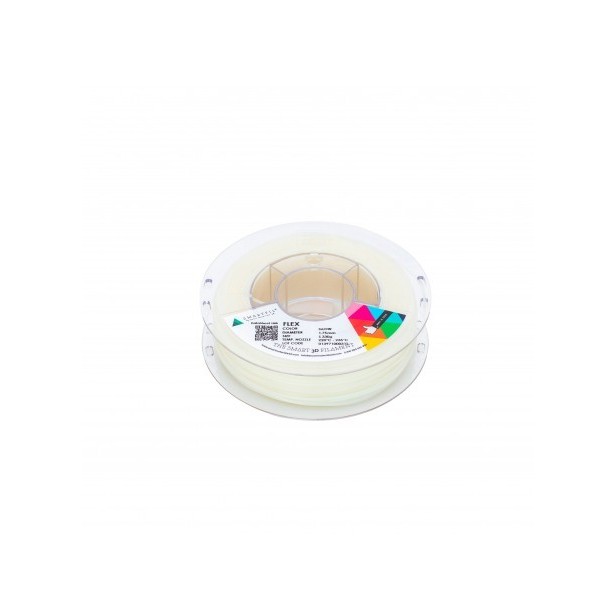- Out-of-Stock
Flexible TPU 93A Glow Filament – Smartfil | 3D Printing
Filament 1.75mm blue flexible and elastic for 3D printer. Made in Spain
330-750g
Te quedan 120€ para el envío gratis

24h Delivery

FREE for orders over 120€

Secure payment
Información del producto
FEATURES – FLEXIBLE GLOW FILAMENT SPOOL:
- Material type: Polyurethane (TPU – Thermoplastic Polyurethane)
- Material property: Flexible
- Filament color: Glow – glows in the dark
- Filament diameter: 1.75 mm / 2.85 mm
- Density: 1.21 g/cm³ (ISO 1183)
- Printer settings:
- Printing temperature: 210 – 235 ºC (225 ºC recommended)
- Heated bed temperature: 0 – 100 ºC
- Cooling fan: 100%
- Print speed: 35 mm/s
- Top layer height: 0.2 mm
- Mechanical properties:
- Hardness: 93 Shore A (ISO 868)
- Abrasion resistance: 35 mm³ (ISO 4649)
- Tear resistance: 180 N/mm (ISO 34-1 B/b)
- Tensile strength: 40 MPa (ISO 37)
- Elongation at break: 500% (ISO 37)
- Modulus at 100% deformation: 9.5 MPa
- Modulus at 300% deformation: 19.5 MPa
- Temperature resistance: 105 ºC
- Recyclable
- Available formats: 330 g / 750 g
- Gross weight: 456 g / 975 g
- Brand: Smartfil
- Manufacturer: Smart Materials 3D
- Country of manufacture: Spain
USES AND APPLICATIONS – TPU GLOW IN THE DARK FILAMENT:
If you're looking to print flexible parts, this is your filament. Common 3D-printed objects made with this material include:
- Footwear
- Automotive components
- RC parts
- Grips and handles
Smartfil Flexible is an elastic filament made of polyurethane, offering high resistance to hydrolysis and oxidation.
Thanks to its 93 Shore A hardness, it's compatible with most desktop 3D printers. If you're using a Bowden extrusion system, make sure your printer supports flexible filaments, as they are harder to push through the tube.
Note that Shore A hardness applies to soft elastomers, while Shore D is used for harder plastics. The higher the number, the higher the hardness.
MANUFACTURER'S PRINTING RECOMMENDATIONS:
This filament is hygroscopic and should be stored sealed in a cool, dry place for optimal performance.
- Ensure continuous flow: Printing TPU is tricky at first. Adjust settings until you achieve consistent extrusion. Use hairspray or adhesive spray for bed adhesion.
- Use the correct temperature: Every printer behaves differently. Start at 225 °C. Higher temps help prevent clogs, but excessive heat may affect part quality.
- Use low printing speed: TPU isn’t meant for high-speed printing like PLA or ABS. Stick to 35 mm/s for clean results.
- Layer height: 0.2 mm for a good balance between detail and speed.
- Disable retractions if you're using a Bowden extruder to avoid clogging issues.
Más productos de Smart Materials 3D






















